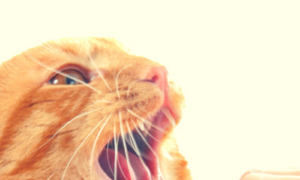By The Daily Cat experts for The Daily Cat

To understand what cat displacement behavior is, let’s first think about humans. When we are bored, we might twiddle our thumbs. When we are nervous, we might bite our fingernails. These are actions with no real goal or purpose, save to alleviate some of the pent-up emotion.
If the person starts to do these things more and more and the problem goes unchecked, he or she could develop what is technically known as a “stereotypy,” which is really just a prolonged, repetitive behavior that serves no apparent purpose and may even be self-destructive.
Cat displacement behavior is “an out-of-context or irrelevant response to anxiety,” according to the organization Cats International. An example they give concerns a harassed cat. The cat could run away or stand its ground and fight. Or, it may surprisingly display another behavior, such as grooming. Grooming causes cats to feel calm and reassured, so the cat is in essence trying to self-medicate during the stressful situation.
Cats are very tidy, and they spend a lot of time grooming themselves. Parasites and other problems can cause biting and skin sores. But if your pet gets a clean bill of health from a veterinarian and yet still seems to engage in unhealthy, repetitive behaviors, you might consider looking at sources of stress. Perhaps a new cat or dog in the house is terrorizing your cat. Maybe a new roommate causes stress, or there is persistent loud noise. The trick is to identify the stressor and remove it. That should end your cat’s need to engage in displacement behaviors.





